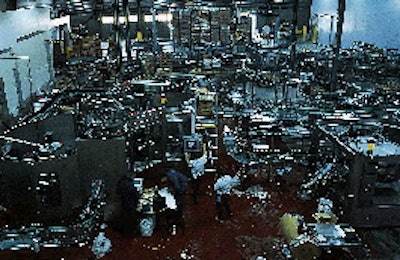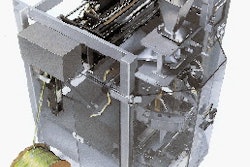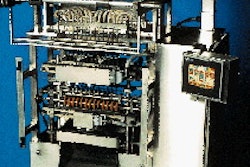Picture this scenario: A packaging line's efficiency slowly drifts downward over time. Anomalies like a labeler slowing down and speeding up due to upstream timing problems or an accumulation table that doesn't empty the way it should, might cause operators to take control of the line, changing settings and running the equipment in manual mode. Then the engineers berate the operators for not understanding how the line should work, while the operators argue that running the line manually is the only way to make the line work as well as it does. Sound familiar? "This goes on all over the place," says Stuart Gittlitz, a computer simulation specialist based in Tarrytown, NY, with Kraft Foods. "We write controls, we put the stuff in, but if there's a problem, the operators cover up photoeyes and run things manually. The operators are [with the line] all the time, and if those controls aren't working, they'll find a way to run the line the best way they can," says Gittlitz. At Amway Corp., Ada, MI, electrical engineer Jay Mol also believes the practice is widespread. "It's something Amway discourages because [tampering with photoeyes] can negate safety features," he says. It could also damage the equipment. "The cost," adds Mol, "depending on what happens, could be significant." There's another cost, of course, when the operators lose faith in the controls logic: lost efficiency. "We just spent five months tuning our line because of stuff like that," Al Triplett tells Packaging World. He's the vice president of brewing at Seattle-based Redhook Ale Brewery. Its showcase Woodinville, WA, plant, built from scratch four years ago with state-of-the-art bottling line equipment, was off to a promising start, but efficiency had sunk to levels as low as 40%. One primary cause: Equipment settings were adjusted with each shift. "It's human nature," says Triplett. When operators perceived a problem, "they'd start fiddling with stuff, and then the next group would come in, and the settings would be totally different from what they were used to." Redhook may not be alone in its predicament. "Rarely do you see a packaging line operating at greater than sixty or sixty-five percent efficiency, and it's [often] just 'people issues,'" believes Dan Alameda. He's a project engineer specializing in packaging at Dole Fresh Vegetables, Soledad, CA, and a former engineer for a packaging machinery OEM. Staying with the line For many engineers and operators, the issue ultimately boils down to getting the engineers to stay with the line long after it's installed to work out even the smallest bugs that can zap efficiency. "It's what I see is really lagging in a lot of plants," says Alameda. Keith Campbell, manager of manufacturing and technical systems at Hershey Foods, Hershey, PA, agrees. "In my experience with other companies in their engineering departments, those departments are very lean. And their job is basically to install a line and then move on to the next job." That's not how it works at Hershey, says Campbell. "We install the system and then live with the operators for a long time after the installation is complete. We keep engineers on the floor until the lines are pretty much hitting their maximum theoretical output. So if there are things that aren't working quite right, the engineers will help operators to get those changes made." SmithKline Beecham also doesn't find this to be an issue, for similar reasons. "Certainly some plants are more efficient than others," says Angelo Scolieri, director, packaging and production technical services, worldwide pharmaceuticals. "But we never walk away from a piece of equipment or a line. We have engineering liaison meetings" to stay in touch with plant personnel once the equipment is installed. Why it happens Operators take matters into their own hands for a variety of reasons. Sometimes what's a priority for the operator isn't for the engineering department. That can tempt operators to make their own changes after perceiving a lack of interest by the engineering department or management. A very common reason for operators to take control relates to how the line ages over time. Gittlitz recalls a specific example at Kraft: "On a fairly simple line-basically just filling a container, labeling it and case packing it-some of the machine speeds had changed over time. But the controls had not been updated to compensate for that. So the operators ran the line in manual mode." In situations like these, operators have little choice. This is something that engineering departments may not realize. Outdated controls strategies are common in Gittlitz's experience. "The hardest thing I do is to try to understand what the control strategy is. Whoever developed those controls is gone, and all you have is physically what's there on the line. Some of the information may be written down, but it may not be totally comprehensible. It's very tough [to understand the documentation] for all the ladder logic that they left behind." At Redhook, three specific reasons caused operators to take control of the line. First, operators on each shift ran the equipment on what they perceived to be the correct setting because there were no standard operating procedures. Second, there was no standard way to troubleshoot equipment. That in turn created its own problems as operators made more and more adjustments to try to fix the original problem. "In thirty minutes they can have a lot of stuff moved around and then we've got to get an electrician in there to figure out what the hell happened," says Triplett. A final problem at Redhook was the operators' tendency to just get the line running again without taking time to root out the underlying cause of downtime. That resulted in a lot of starts and stops that sapped efficiency. "It was hard to get people over that tendency and say okay, it's not important that we just get it running," says Triplett. "We're not helping the efficiency if we have to have a guy run over and hit reset every time something happens." Solutions Of course, the ideal solution to these problems is to prevent them from occurring in the first place. One way is to have engineers live with the operators on the line when it's first commissioned, the way Hershey does. But that's an expensive option that may not be available to smaller- to medium-sized companies that lack a big engineering department. Another approach, admittedly more effective for larger firms, is to create an independent "S.W.A.T." team whose sole job is to move from line to line, ferreting out problems and inefficiencies, including those caused by or that result in operators taking control of the line. Sound far-fetched? SmithKline Beecham's Scolieri assembled just such a team, consisting of four people, two years ago. It is more than paying for itself. "Last year they saved two million dollars without any capital expenditures," says Scolieri. "They go out and survey a line, find out what's killing the efficiency and throughput. They collect some data and analyze it. Then they group it-is it procedural, is it equipment-related or is it material-related?" The team is winning rave reviews from those plants that it helps. "Right now, I have two guys practically living over in England," says Scolieri. "The plant manager there is absolutely ecstatic because we're going to enable them to meet their goals three to five years out without any major capital expenditures." For smaller companies without the staff (or the number of packaging lines) to warrant such a full-time group, there is little choice except to assign engineers to troubled packaging lines, digging through all the issues that are contributing to lost efficiency, which takes time and money. That's what Redhook did. And it started by listening to the operators. Mike Reckard, a lead operator at Redhook's Woodinville bottling plant, says he and his coworkers got to tell their side of the story-in many cases demonstrating problems on the line to the engineers. "For instance, on the filler, the programmer sat with us and when he noticed short fills, he [kept altering the programming] until it finally worked," Reckard tells PW. "Now that they're actually sitting down and watching what happens, it's a big difference," says Reckard. "What I say [as an operator] doesn't mean much until [an engineer] sees it. And they're coming down and sitting here for all-day shifts, just watching, writing down problems and working with us." Training for consistency At Redhook, part of the solution consisted of altering some of the PLC programming to update the controls to reflect the day-to-day realities that the operators were experiencing. The brewery also made some adjustments on the line, such as adding photoeyes. Training, too, was a critical part of the solution, says Triplett. Previously, there hadn't been any consistency to training; different operators each had their own methods of operating the equipment. Now, a designated group of personnel handle training, "so everyone's getting one message, not two or three," says Triplett. "It has made a huge difference." It also makes a difference when everyone is trained how to troubleshoot in the same way. "They can step right in and go through a systematic troubleshooting. That in itself is a big time-saver." Triplett also took the opportunity to bring in some OEM representatives to conduct refresher training on the equipment. And of course, there is now a complete set of standard operating procedures in force. The benefit to all these changes? "Before, our efficiencies had sunk to forty or fifty percent," says Triplett, "and now we're up to seventy or eighty, and we should be in the nineties soon." At Kraft, Gittlitz uses computer software to simulate problematic packaging lines, conducting "what-if" sessions with the operators until a solution is developed. "I have them toss out suggestions to me, and I just simulate it [on a computer] for them right in front of them, saying okay, you want to put a control over here? If we had the control working, would you now let the line run in automatic mode?" Designing for the bad days One way to minimize the potential for operators to take control of the packaging line is to try to anticipate as many problems as possible when the line is still on the drawing board. Or as Gittlitz puts it: "Design for the bad days." He gives an example of a line design under consideration that included three parallel tamper-evident banders. One question that came up was: How can the line be designed to still run successfully if any one of those three is down? The solution was to design the controls to permit the line to operate successfully with "a bunch of different speeds, [incorporating] additional control logic and different conveyor logic," says Gittlitz. "Because we want to build this line today for that future occasion when we're only running one or two of the three." That's how the line design process should work in theory, says Gittlitz. The reality is the person who writes the controls logic-often an outside vendor-is different from the person who designed the line: the packaging engineer. In theory, the engineer should articulate the controls strategy to the vendor. But engineers are trying to meet such tight schedules for product launches, observes Gittlitz, that upon receiving an assignment, they barely have time to "get on the phone and start calling up vendors, [let alone] theorize how that line might run or fail." And when problems eventually arise, engineers are often surprised to find that they're related to the line design. They may think to themselves, says Gittlitz, "Everything was put together right. But those people in the plant, they just didn't put enough time into it, or they didn't put the maintenance into it, or they didn't put the training into it. So of course it's not working." Only after investigation do they sometimes learn that controls are part of the problem. Gittlitz points out that he's not picking on the engineers. In fact, he sympathizes with their plight. "Nobody wants to install a six-hundred-thousand-dollar packaging line whose controls are being bypassed," he says. "It's extremely tough to deal with, particularly because the lines really do run better when the controls are working!" Ultimately, lines aren't designed in a vacuum, says Dole's Alameda. "What looks good on paper and what works well in a real-world environment are two different things," he says. "You can rarely meet [theoretical efficiencies] without getting operators, maintenance, engineers and management to really work together to get the system to work at its peak." Operators don't just change controls for the sake of changing them, Gittlitz says. They're reacting to something that's not working right. In his experience, working closely with operators can be the foundation for a turnaround of a troubled line, he says. Has it worked at Kraft? "Absolutely," he concludes. "Once you've got them on your side, they will make it work."
























